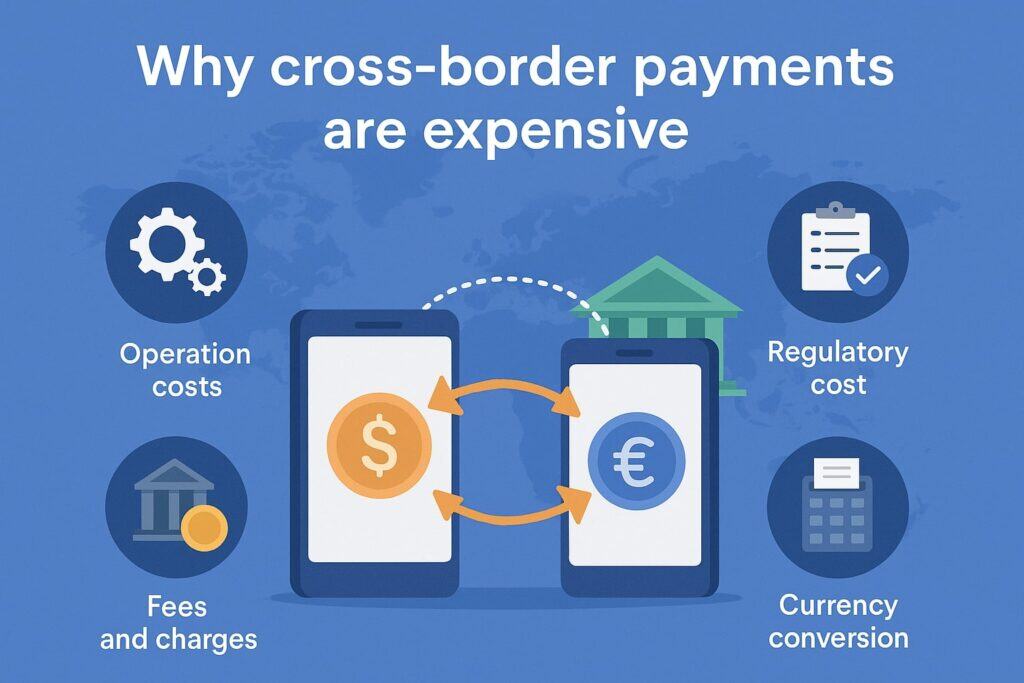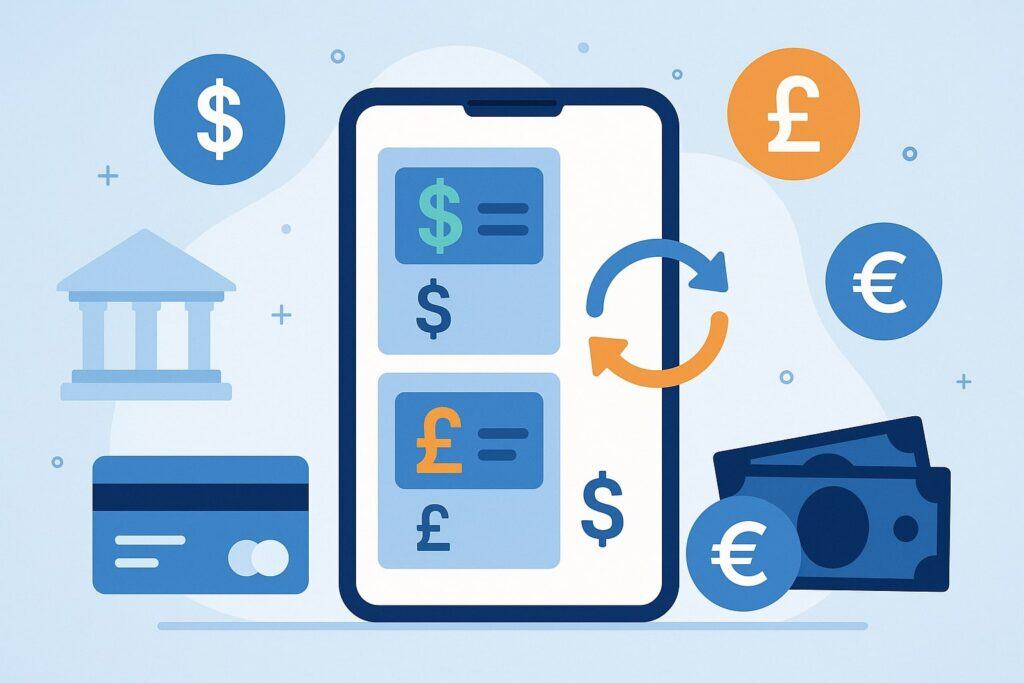
By crossborderfees October 11, 2025
Cross-border payments power global commerce, but they also carry hidden friction: foreign exchange (FX) spreads, correspondent banking fees, card scheme markups, and compliance overhead.
Choosing the best alternative payment methods to avoid cross-border costs can reduce your total cost of acceptance, speed up settlement, and improve authorization rates.
In this up-to-date guide, you’ll learn which rails, account structures, and optimization tactics meaningfully lower fees—without sacrificing compliance or customer experience.
We’ll cover instant payment schemes, multi-currency accounts, account-to-account (A2A) checkout, wallet acceptance, and SWIFT gpi for B2B, alongside practical playbooks you can deploy this quarter.
Why cross-border payments are expensive—and where you can save

The true price of moving money across borders is a stack of small charges that add up. FX spreads are often bundled into “zero-fee” offers but can silently cost more than transparent transfer fees. Intermediary banks can take lifting fees.
Card networks apply cross-border assessment charges, and acquirers may add cross-border markups when the merchant, cardholder, or acquirer are in different countries. On top of that, authorization rates can drop on foreign cards, increasing retries and operational costs.
The best alternative payment methods to avoid cross-border costs focus on cutting out intermediaries, localizing where funds are collected and paid out, and using domestic rails to avoid scheme-level cross-border surcharges.
For consumer P2P and remittances, the World Bank’s Remittance Prices Worldwide shows global average costs remain materially above policy targets, underscoring how FX and fees still bite.
Businesses can learn from the most efficient corridors by routing funds locally, keeping conversions minimal, and negotiating transparent spreads. Adopting instant and domestic schemes where your buyers already bank, and settling into local currency balances, are reliable levers to trim costs while maintaining speed and safety.
Use domestic instant payment rails to “go local” and skip card cross-border markups
Instant payment schemes let funds move within seconds on domestic rails—often with lower fees than cards. For the EU, the new Instant Payments Regulation (IPR) has accelerated the rollout of euro-denominated instant credit transfers, pushing banks and PSPs to offer 24/7 instant payments with verification of payee.
For merchants and marketplaces selling into the EU, steering customers to instant A2A options reduces interchange-like costs and can improve conversion by matching local preferences.
In the U.S., The Clearing House’s RTP® network and the Federal Reserve’s FedNow® Service provide real-time clearing and settlement, expanding B2B and payout use cases with immediate availability and fewer reversals than card rails.
These domestic schemes enable you to collect and disburse in-country, minimizing cross-border costs at the edge.
Operationally, instant rails shine for payouts (creator economies, gig platforms, travel refunds, insurance claims) and for pay-by-bank checkout where available.
Fraud dynamics differ from cards: there are fewer chargebacks, but you must implement strong confirmation-of-payee, bank-level authentication, and robust customer messaging to mitigate authorized push payment (APP) risks.
For your finance team, instant rails can reduce working-capital buffers because funds are final and fast, streamlining reconciliation and cash positioning.
SEPA Instant in the EU: faster euro payments, lower friction
The EU’s IPR (Regulation (EU) 2024/886) mandates widespread availability of instant euro credit transfers and introduces verification of payee (VoP) to reduce misdirected payments and fraud.
Practically, this means European customers can send you money in seconds, 24/7/365, with their bank confirming the recipient name matches the IBAN before release.
For merchants and B2B billers, offering SEPA Instant at checkout or as a pay-by-link option can sidestep card cross-border charges when the buyer and your collection account are both in the SEPA zone. Settlement is typically cheaper than card acquiring, and reconciliation improves because the payment carries structured data.
To capture these benefits, open a euro IBAN within the SEPA area (via your bank or a licensed PSP) and enable instant collection. Use a payment initiation provider (PISP) or PSD2-enabled open banking flow to trigger instant pay-ins directly from customer bank accounts.
Pair VoP with your CRM to pre-fill beneficiary details and reduce payer friction. For marketplaces, combine instant rails with split-payout logic to vendors’ EU bank accounts—keeping funds domestic and avoiding repeated FX.
The European Payments Council’s SCT Inst rulebook aligns with the IPR, and banks are rolling out compliant services; it’s an ideal time to test A/B checkout placement for SEPA Instant.
U.S. instant rails: RTP and FedNow for real-time B2B, payouts, and A2A
In the U.S., instant payments are no longer theoretical. The RTP network surpassed one billion payments and continues to scale volume and value, reflecting rapid adoption by banks and businesses.
FedNow launched in July 2023 and now counts hundreds of participating institutions, expanding coverage and redundancy. For cost control, these rails help you avoid card cross-border and assessment fees when paying U.S. suppliers or disbursing to U.S. recipients.
They also reduce exceptions and late fees in B2B flows thanks to immediate posting and richer remittance data, improving straight-through reconciliation.
Implementation tips: select a bank or fintech sponsor with both RTP and FedNow connectivity; map use cases (supplier payments, just-in-time inventory, wages, refunds); configure amount limits and risk controls per rail; and instrument your ERP with ISO 20022 payment data for clean reconciliation.
For cross-border trade with a U.S. leg, collect domestically into dollars via A2A or RTP, then convert once inside multi-currency accounts (see below) to avoid multiple FX hops. This approach—collect local, settle once—is a hallmark of the best alternative payment methods to avoid cross-border costs in the U.S. market.
Open multi-currency accounts and collect “like-for-like” to eliminate needless FX

A powerful, vendor-agnostic tactic is to collect in the shopper’s currency and hold balances in that currency until you actually need to convert. Multi-currency business accounts (with local bank details like GB sort codes, EU IBANs, U.S. routing numbers) let you make your buyer’s payment domestic, not cross-border.
That instantly removes card cross-border assessments and acquirer markups tied to foreign transactions. It also increases authorization rates because issuing banks prefer domestic transactions, and it reduces disputes caused by confusing FX on card statements.
To do this well, map your top ten buyer currencies and open local receiving accounts for each. Price in local currency and accept account-to-account pay-ins (SEPA, Faster Payments, ACH, RTP, FedNow) and popular domestic wallets.
Keep funds in “like-for-like” currency and net your AP/AR in the same currency to minimize conversions. When conversion is required, use transparent mid-market spreads with scheduled batch conversions.
This simple architectural shift—collect local, hold local, convert on your terms—sits at the core of the best alternative payment methods to avoid cross-border costs, because it attacks the largest silent fee: FX spread bloat.
Offer account-to-account (A2A) checkout and local wallets where your buyers already are

Card payments are ubiquitous, but they’re not always the cheapest or most trusted in every market. A2A “pay by bank” via open banking is now mainstream across Europe and growing elsewhere, providing SCA-compliant flows and instant settlement on local rails.
In markets like India (UPI), Brazil (Pix), and the Netherlands (iDEAL), bank-based payments or local wallets dominate consumer behavior. Adding these alternative payment methods to avoid cross-border costs lets you route transactions domestically—often with lower fees, faster settlement, and fewer chargebacks.
Design tips: present local payment methods dynamically based on geolocation, device locale, or BIN/currency recognition; prefill bank details and beneficiary names for VoP; and use deep links into banking apps to reduce friction.
For wallets, ensure tokenized credentials on file so you can support one-click repeat purchases without storing sensitive PAN data. Finally, measure post-checkout impact: authorization rate uplift, cost per successful payment, and time-to-cash.
In many markets, shifting even 20–30% of volume from international cards to domestic A2A or wallets produces outsized savings on cross-border and scheme fees—without degrading conversion.
Control FX explicitly: mid-market pricing, batching, and natural hedges
The invisible part of cross-border cost is often FX. Many providers quote “free” transfers but recover economics through wide spreads.
Treat FX like any other procurement category: demand mid-market quotes with a clearly stated markup in basis points; batch conversions at predictable windows; and blend in natural hedges by paying suppliers in the same currency in which you collect revenue.
If you operate a marketplace, consider currency selection rules for sellers (e.g., default to their domestic currency) and schedule payouts to line up with your FX conversion windows.
For larger exposures, simple hedging tools—such as forwards and layered tenors—can smooth margins. Work with your treasury team and provider to define thresholds: automatic hedging for exposures beyond X in a rolling 30- or 90-day window, with monthly reviews.
Also ensure you’re using ISO 20022 remittance fields to carry invoice references, tax breakdowns, and contract IDs through the payment, so reconciliation remains robust even as you batch FX.
Owning FX policy and data closes one of the biggest leaks and complements the best alternative payment methods to avoid cross-border costs you adopt elsewhere.
Optimize card acceptance when cards are unavoidable
Sometimes cards are the only viable option—think cross-border travel, on-demand digital content, or long-tail geographies. Even then, you can reduce cross-border costs.
First, localize acquiring by using an acquirer in the buyer’s region to raise authorization rates and avoid cross-border scheme assessments. Second, enable network tokens and 3-D Secure 2 to reduce declines and fraud without relying on blunt risk rules that trigger retries and extra processing.
Third, negotiate interchange-plus with transparent cross-border markups, and monitor cross-border indicator flags to ensure transactions that “should” be domestic aren’t being misrouted as international.
BIN-level routing helps steer certain issuers to better-performing acquirers, while soft descriptors reduce customer confusion about FX fluctuations on statements. If you run subscriptions, store credentials using network tokens to survive card re-issuance and reduce involuntary churn.
Cards won’t be your cheapest path, but disciplined routing, localized acquiring, and clear pricing terms keep their share of wallet aligned with value. Used alongside domestic A2A and wallets, cards become a strategic complement—not a cost anchor.
For B2B cross-border: SWIFT gpi, virtual accounts, and rich data
For invoices and supplier payments, SWIFT gpi dramatically improves speed and transparency over legacy correspondent chains by enabling end-to-end tracking and predictable credit times.
SWIFT has reported that the vast majority of cross-border payments on its network now reach the destination bank within an hour—well ahead of G20 targets—although final credit to the end customer can still vary by local banking processes.
For finance teams, gpi’s tracker reduces “where is my payment?” tickets and shortens days payable outstanding (DPO) disputes. Pair gpi with virtual accounts and unique IBANs per customer or market to automate receivables matching and keep funds segregated by currency.
Data matters as much as rails. Move to ISO 20022 messages so remittance information survives hops and can be parsed by your ERP. Use purpose codes where required to avoid compliance holds.
If you collect in-market using local rails and then settle via gpi from your regional treasury centers, you’ll often achieve lower end-to-end costs than sending everything as international wires from HQ—another hallmark of the best alternative payment methods to avoid cross-border costs in B2B.
Implementation blueprint: how to roll out lower-cost alternatives in one quarter
Start with data. Build a payment cost waterfall by corridor: card scheme fees, cross-border assessments, acquirer markup, FX spread, gateway fees, and operational exceptions. Segment by currency and payment method to find the top five “expensive corridors.”
Next, pick two to three alternative methods per corridor—e.g., SEPA Instant + open banking in the EU; Pix/boletos in Brazil; RTP/FedNow for U.S. payouts—and run a 90-day pilot with clear success metrics: cost per successful payment, conversion, time-to-cash, and dispute rate.
On the tech side, choose a PSP or orchestration layer that supports:
(1) dynamic payment-method display,
(2) multi-acquirer routing,
(3) local collection accounts,
(4) instant rails connectivity, and
(5) ISO 20022 data. Configure verification of payee, device binding, and transaction risk analysis (TRA) where available to keep fraud low on A2A.
Finance should open local currency accounts in target markets and define FX policy (markup caps, batch windows). By the end of the quarter, roll the winning flow to 100% of eligible traffic and expand to the next corridor.
This execution rhythm makes the best alternative payment methods to avoid cross-border costs a compounding advantage instead of a one-off test.
Compliance and risk: keep instant & A2A fast, safe, and audit-ready
Alternative methods shift risk types, not risk itself. With A2A and instant rails, fraud risk tilts toward social engineering and authorized push payment (APP) scams. Implement verification of payee where supported, strong payer authentication, and real-time confirmation screens that restate beneficiary names and refund policies.
Build positive payee lists for repeat customers and velocity checks for new ones. For wallets, rely on device-level trust signals and issuer-side risk controls. For B2B, align purpose codes and invoice data with local regulations to avoid repair queues.
On the AML side, screen counterparties continuously—not just at onboarding—especially for marketplace payouts. Maintain travel-rule compliance where required, and keep robust logs of consent for open-banking-initiated payments.
Use ISO 20022 fields to carry KYC and tax data alongside payments to reduce manual intervention. Finally, document your payment-method selection logic and routing rules; auditors and partners increasingly expect explainability for why traffic is steered to certain rails.
Done right, you’ll preserve the speed and savings of the best alternative payment methods to avoid cross-border costs while keeping governance rock-solid.
FAQs
Q.1: What’s the single fastest way to lower cross-border costs without hurting conversion?
Answer: Start by localizing collections for your top buyer currencies. Open local currency accounts (or virtual accounts) and present domestic payment methods first—SEPA Instant in the EU, A2A open-banking flows where mature, popular wallets in wallet-first markets, and bank transfers in APAC corridors.
Then, default to pricing in the customer’s local currency and settle into like-for-like balances. This alone removes card cross-border assessments and reduces FX conversions.
For the U.S., use RTP/FedNow for payouts and supplier payables to avoid card rails and wire fees; in Europe, leverage SEPA Instant with verification of payee to reduce misdirected payments and speed settlement.
Combine this with an explicit FX policy—mid-market plus a capped markup—and you’ll usually see a measurable drop in cost-per-successful-payment within one quarter.
Q.2: Are instant payment rails really cheaper than cards for businesses?
Answer: While exact pricing depends on your bank or PSP, instant rails typically charge either a flat network fee or a small per-payment fee that’s lower than blended card costs—especially once you factor in cross-border assessments and international interchange.
You also avoid chargeback fees, since instant A2A payments are typically irrevocable. That said, you must invest in authorization UX (clear call-outs, bank-app deep links) and fraud controls (verification of payee, behavioral risk signals).
In markets with strong consumer preference for bank payments (e.g., much of the EU) or high wallet penetration, swapping a portion of card volume to A2A/wallets can lower total cost of acceptance while maintaining or improving conversion.
Recent policy moves in the EU (IPR) and U.S. network growth (RTP/FedNow) make the economics more accessible than ever.
Q.3: What about B2B international wires—aren’t they still slow and expensive?
Answer: Legacy cross-border wires can be opaque, but SWIFT gpi has changed the baseline. With gpi, most cross-border payments now reach the destination bank within about an hour, with end-to-end tracking so you and your supplier see status updates and timestamps.
Costs still vary by corridor and correspondent chain, but gpi plus virtual accounts and ISO 20022 remittance data dramatically reduces reconciliation effort and exception handling.
To control fees, keep as much of the transaction domestic as possible: collect locally into regional currency accounts, then make a single, well-priced gpi payment from your treasury center when needed. This approach often beats one-off international wires launched directly from a foreign acquirer or card settlement.
Conclusion
There’s no single silver bullet—costs hide in different parts of the flow. But the pattern is clear: the best alternative payment methods to avoid cross-border costs combine (1) local collection on domestic instant rails and A2A, (2) multi-currency accounts to hold funds like-for-like, (3) explicit FX policy with mid-market pricing and batching, (4) card routing and localized acquiring only where cards add value, and (5) SWIFT gpi plus rich data for B2B.
With a data-driven pilot across your top corridors, you can move 20–40% of volume to lower-cost methods, improve approval rates, and shorten time-to-cash—while preserving a customer-friendly checkout and payout experience.
Start with your most expensive corridor, localize, and convert once on your terms. That’s how modern teams turn cross-border from a cost center into a competitive advantage.